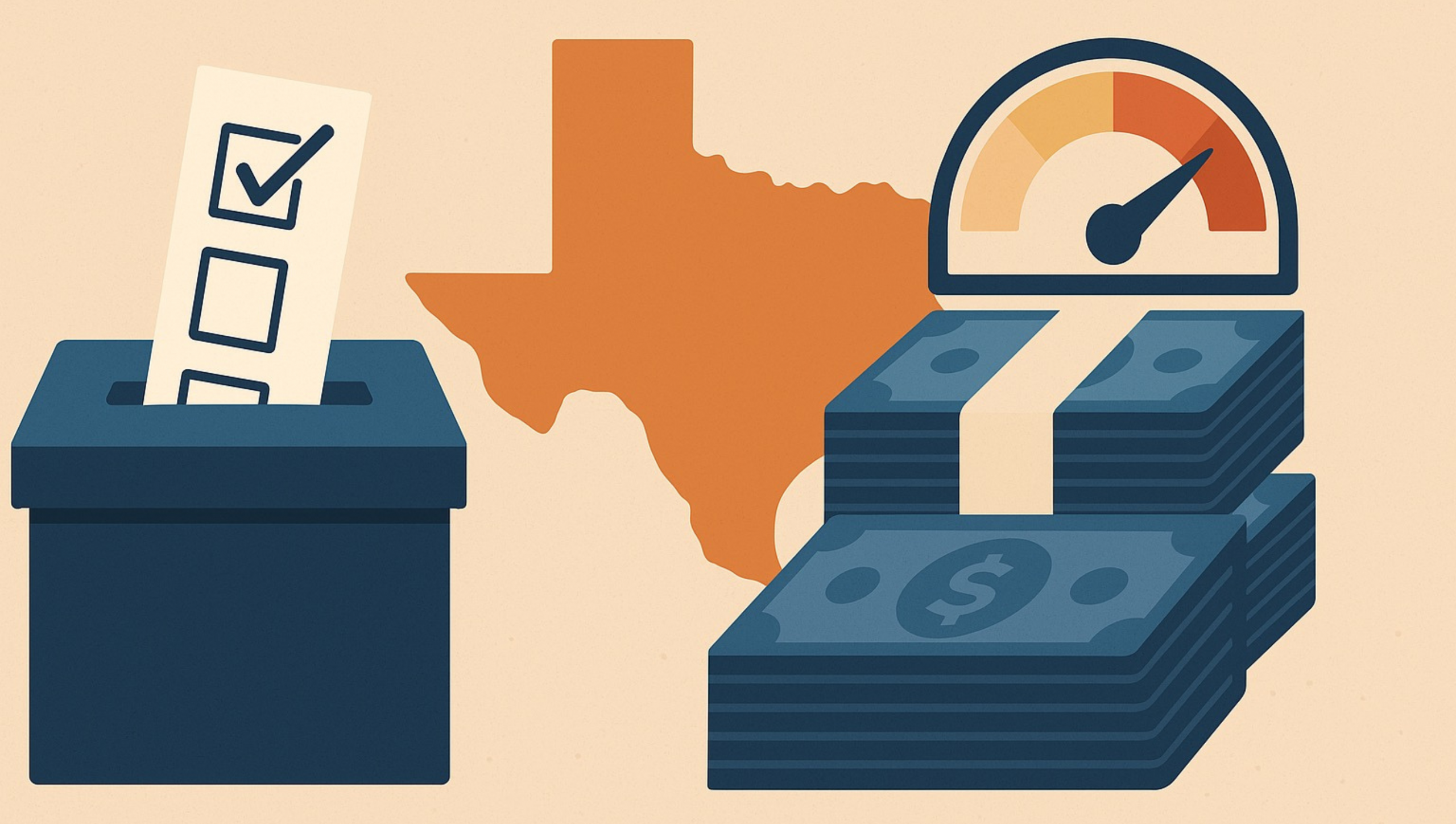Executive Summary
The only thing the Texas Legislature must do when they meet every two years is adopt a budget.
Not surprisingly, with years of practice they have gotten pretty good at spending taxpayers’ money.
For instance, the Legislature appropriated $323.8 billion over the most recently completed (2022-23) two-year (biennial) budget cycle. That is up 19.8% over the previous biennium. State appropriations increased by 26%.
But this doesn’t tell the whole story of how much the state of Texas is spending. Billions of dollars of state spending do not show up in the state’s appropriations as documented by the Legislative Budget Board’s (LBB).
State of Texas Annual Comprehensive Financial Report
The actual spending numbers, contained in the State of Texas Annual Comprehensive Financial Report (obtained from the Texas Comptroller), show that Texas’ annual spending over the last decade has been anywhere from 23% to 53% greater than the LBB figures show. For the 2022-2023 biennial budget, actual state spending is $399.8 billion, 23.5% more than the LBB figures show. Those who are concerned about the ever-increasing size of Texas government have more to be concerned about than we thought.
The Legislative Budget Board v. the Texas Comptroller of Public Accounts
On the one hand, there is nothing particularly sinister about the LBB’s budget numbers. They are designed to show how much the Legislature appropriated, not how much the state and its agencies, colleges, etc. spend. On the other hand, it is certainly convenient that the official government numbers that are most highly scrutinized by the public do not accurately represent the size of Texas government and its spending. And past history shows that this might not be entirely innocent.
| Figure 1: Legislative Appropriations vs. Actual Spending | ||||
| LBB Appropriations | Comptroller Actual Spending | Difference | % | |
| 2012-13 | $185,254,700,000 | $241,974,151,000 | $56,719,451,000 | 30.62% |
| 2014-15 | $203,300,500,000 | $260,750,406,000 | $57,449,906,000 | 28.26% |
| 2016-17 | $216,398,400,000 | $284,309,764,000 | $67,911,364,000 | 31.38% |
| 2018-19 | $235,222,275,833 | $292,106,986,000 | $56,884,710,167 | 24.18% |
| 2020-21 | $270,340,500,000 | $413,554,629,000 | $143,214,129,000 | 52.98% |
| 2022-23 | $323,816,400,000 | $399,841,717,000 | $76,025,317,000 | 23.48% |
| Average | $76,367,479,528 | 31.82% | ||
When the LBB released its initial appropriations numbers for the 2013 session of the Texas Legislature, it showed the Legislature had appropriated $131.7 billion, a 10.8% increase over the initial appropriation in 2011. But as it turned out, something was missing. The LBB had failed to include certain health care expenditures in its numbers; $6.1 billion of state expenditures had magically disappeared from the budget.
Except it was not magic.
The elected leaders of the LBB (the lieutenant governor, speaker of the House, four senators, and four house members) had made the decision to no longer include state expenditures related to patient income as appropriated funding. Thus what was officially reported as a 10.8% increase in appropriations was actually a 16.8% increase, which certainly would have been less palatable to a majority of their constituents back home.
Regardless of why Texas politicians decided not to include significant amounts of state spending in budget documents, the fact is that the LBB’s numbers do not show the full size of Texas government. Figure 1 shows that over the last decade, on average $76.4 billion (32%) of state spending is not included in the LBB’s budget figures. The high (or low) point of this was the 2020-21 fiscal biennium, where $143 billion (53%) of state spending, was not included in the Legislature’s budget numbers.
Politically, this is highly beneficial for Texas’ governor, lieutenant governor, the House speaker, and members of the Texas Legislature. Since the state operates on a biennial basis, the comptroller’s numbers are not available until more than two years have passed since the Legislature made the decisions that determined the size of Texas government. By then, almost no one pays attention to the numbers and no politicians are held accountable.
The Big Business of Texas Government
Many Texans are wary of Big Business today. And for good reason. Big Pharma made hundreds of billions from government by pushing a false narrative about the harm caused by the SARS-CoV-2 virus and the efficacy and safety of their vaccines. Big Energy is making hundreds of billions from government by pushing a false narrative about climate change. And Big Media is making hundreds of billions (much of it from government) by pushing a false narrative about misinformation while censoring Americans’ speech.
However, sometimes we forget that Texas government is itself a Big Business. In fact, its business activity ranks up there with most of the Fortune 500 companies based in Texas. In its Annual Comprehensive Financial Report, the Comptroller breaks down state activities into two categories, Governmental Activities and Business-Type Activities. The business-type activities listed in Figure 2 show just how big a business Texas government is.
| Figure 2: Business-Type Expenditures of the State of Texas – 2023 | |
| General Government | $284,849,000 |
| Education | $43,635,059,000 |
| Health and Human Services | $2,383,827,000 |
| Public Safety and Corrections | $117,332,000 |
| Transportation | $678,327,000 |
| Natural Resources and Recreation | $651,703,000 |
| Lottery | $6,435,017,000 |
| Total Business-Type Activities | $54,186,114,000 |
Texas business-type expenditures of $54.2 billion are on par with Texas companies like Oracle ($37.6 billion), Caterpillar ($54.1 billion), and American Airlines ($50 billion). And just like many big businesses, the state of Texas is in the business of pushing false narratives, censoring speech, and oppressing Texans—and using our money to do so.
Perhaps the main difference between the state and other big businesses is that the state is not a very successful business—the Comptroller’ report shows it operating at a $1.3 billion loss in 2023.
However We Measure It, Texas Government Keeps Growing
Despite the differences reported in the amount money being spent by Texas government, the numbers from both the LBB and the Comptroller show a similar growth of government over the last decade. As seen in Figure 3, the LBB reports the Texas budget increased on average by 5.7% annually from 2012 to 2023, while the Comptroller reports the annual growth of Texas government spending at 5.1% over the same period. Over the last five years, the annual increase jumped to between 6.6% and 7.2%. Inflation plus population growth during that period was only 4.9%.
| Figure 3: Spending Growth of Texas Government 2012-23 | ||||
| Biennium | Biennial Budget(LBB) | Increase | Biennial Spending(Comptroller) | Increase |
| 2012-13 | $185,254,700,000 | $241,974,151,000 | ||
| 2014-15 | $203,300,500,000 | 9.74% | $260,750,406,000 | 7.76% |
| 2016-17 | $216,398,400,000 | 6.44% | $284,309,764,000 | 9.04% |
| 2018-19 | $235,222,275,833 | 8.70% | $292,106,986,000 | 2.74% |
| 2020-21 | $270,340,500,000 | 14.93% | $413,554,629,000 | 41.58% |
| 2022-23 | $323,816,400,000 | 19.78% | $399,841,717,000 | -3.32% |
| Total | 74.8% | 65.2% | ||
| Avg. Annual | 5.7% | 5.1% | ||
| Avg. 2019-23 | 6.6% | 7.2% | ||
This means that the money paid to government by Texas taxpayers and consumers has increased as well, by a total of between 65% and 75% over the last decade. Texas government keeps growing, and so does the burden on Texans to keep funding it.
More Spending Equals More Government and Less Liberty
Over the last couple of decades, conservatives began seeking to limit the growth of government to population growth plus inflation. Given that government spending was outpacing those measures, the idea was laudable. But that is no longer the case. Not only has the effort failed, it has been compromised. And, most importantly, the consequences of allowing the size and scope of government to increase have become obvious to everyone.
It has been the growth of Texas government spending that gave it the personnel to enforce the state-wide lockdowns during COVID-19. It is the growth of Texas government spending that has given it the ability to enforce speech codes on the Internet. It is the growth of Texas government spending that has given it the bureaucracy to persecute medical doctors for successfully treating their patients. And it is the growth of Texas government to continues to drain the bank accounts of Texans and makes life less affordable every year.
The only way to stop these things from happening is to stop the growth of Texas government spending. That is why the standard for the increase of Texas government spending should be zero growth. Freezing the growth of Texas government spending is the only way to ensure liberty for Texans. Otherwise, more government spending means more laws, regulations, and bureaucrats that will further restrict liberty.
And those will come on top of the already oppressive laws, regulations, and bureaucrats that are supported by Texas’ current $200+ billion a year spending.
Texans for Fiscal Responsibility relies on the support of private donors across the Lone Star State in order to promote fiscal responsibility and pro-taxpayer government in Texas. Please consider supporting our efforts! Thank you!
Get The Fiscal Note, our free weekly roll-up on all the current events that could impact your wallet. Subscribe today!




